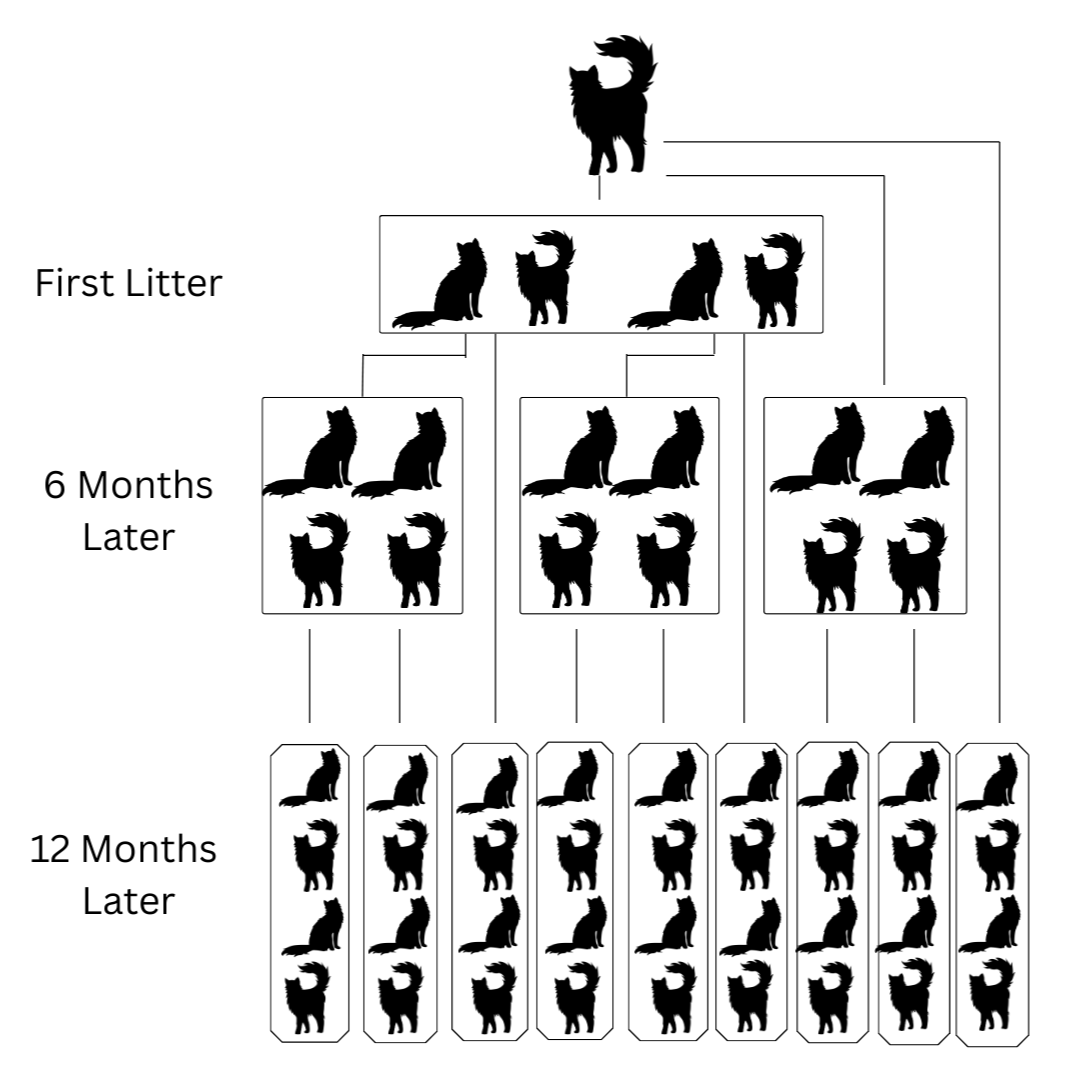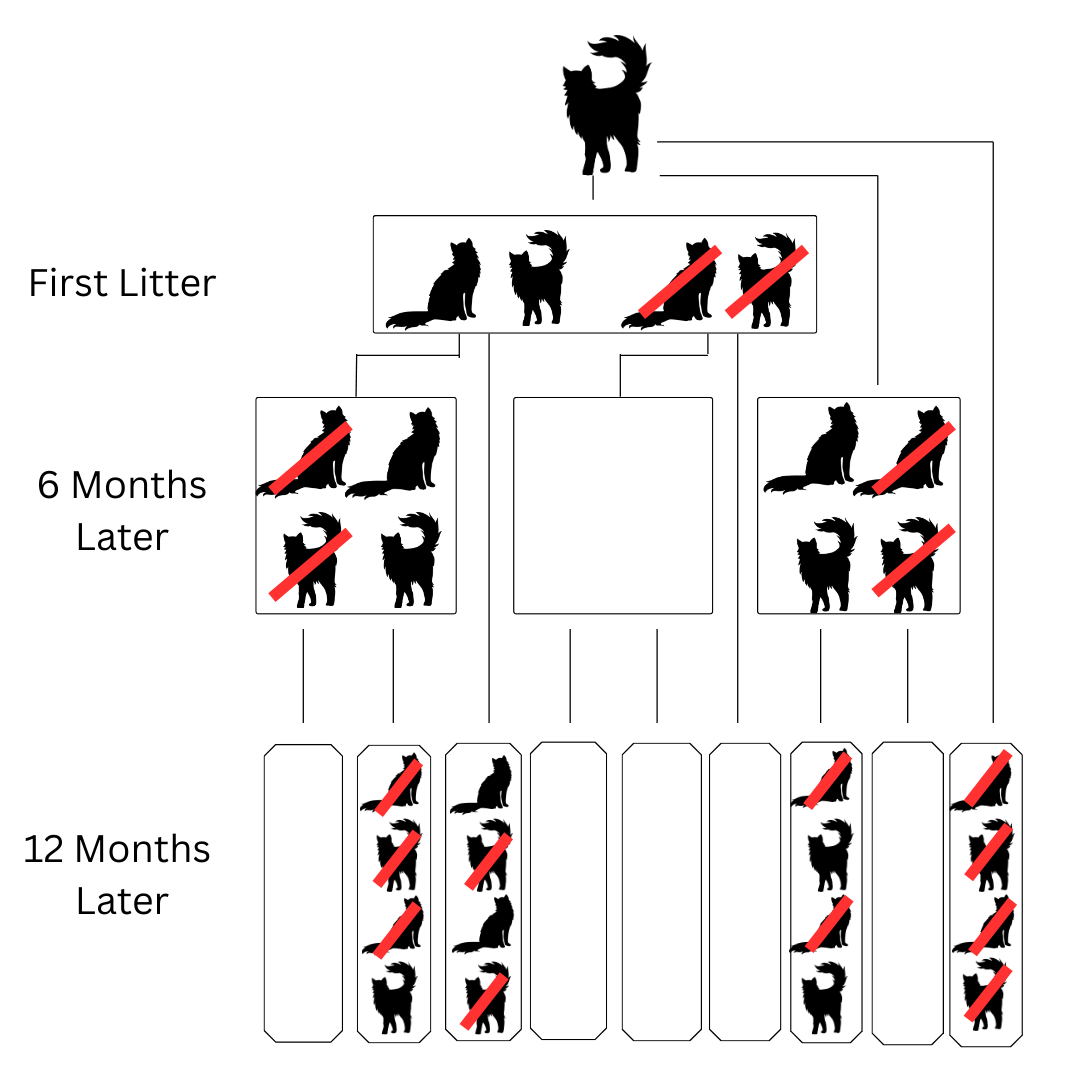Trap - Neuter - Return (TNR) ... What is it?
TNR… What is it?
Trap/Neuter/Return is a humane method of helping to control outdoor cat populations. Using live traps, you trap community cats, take them in for spay/neuter, they are given a rabies vaccination, then ear tipped on the left ear to indicate they have been spayed/neutered.
What are the benefits of TNR?
TNR helps reduce many problem behaviors in outdoor cats. Whether a friendly community cat that lives outside or a feral cat that is scared of humans, getting them sterilized reduces behaviors such as noisy mating sessions, spraying/marking, fighting for breeding rights or territory, wandering out further to expand territory and find other cats to mate with and so much more. But the largest benefit is no more kittens born outside.
Did you know? Up to 80% of kittens born outside do not make it to 6 months of age due to illness, weather, inexperienced mothers, inbreeding and other issues that arise. It is so important to get the outdoor kitties fixed to help prevent suffering of future kittens.
Ever see this image or one like it?

This image is a false representation of what really happens. Obviously we don’t see an influx of cats like this in feral colonies, otherwise we wouldn’t be able to walk outside without tripping over cats. What many fail to realize and what is never talked about is with every generation, 80% of those cats that are born die. But we can prevent it from happening with TNR!
Here is a more correct representation of what happens to outdoor cats left to reproduce.

The ones with /’s are ones that didn’t make it to 6 months of age, the ones covered in red were never born due to that. While this may seem like a lot less cats, the reality is it's a lot more sad. So many kittens are suffering outside, and the only way to stop it is to get them spayed or neutered!
It also helps keep the adults that did make it much healthier and happier. They no longer have to drift around and just survive while being driven by instincts to eat, fight, reproduce and repeat. They can begin to thrive!
How can you help?
Grab a trap and begin the journey! At Columbia Second Chance we rent out traps for a $25 deposit. Once you return the trap cleaned and in working order, you get that deposit returned to you.
“But I don’t know how to trap a cat!”
No worries! We have a
step by step guide ready to help teach you the basics! You can always email our TNR team for added tips and tricks as well for harder to catch kitties.
“I caught a cat! Where do I take it to get fixed?”
Always schedule or plan ahead when planning to trap a cat. You never want to let a feral loose in your house as they can hurt you, themselves, others and will destroy your house, even if in a small room. They will be terrified. Because of this you will need to keep them in the live humane trap until they are fixed and ready to be released back outdoors.
They
HAVE to be taken in a live trap in order to get the TNR pricing.
You can call the Spay and Neuter Project to request an appointment with them. They charge $40 for a feral and it includes the spay/neuter, rabies vaccine, and ear tip. If you want anything extra given you can request it at an extra charge. (FIV/FeLV testing, FVRCP, etc).
See more info here: https://www.spayneuterprojectmo.org/service
The other option is taking them to the Central Missouri Humane Society. Their TNR program charges $25/feral cat.
Again, if you want anything extra given you can request it at an extra charge. (FIV/FeLV testing, FVRCP, etc). CMHS does not do appointments for feral cats and are on a first come, first serve basis. You can arrive a little before 7:30am with your cat in a trap on Tuesdays/Wednesdays/Thursdays.
I recommend getting there right before because if others beat you there, you will be stuck with a cat in a trap. Releasing a feral back outside unfixed will be SUPER hard to retrap most of the time. They are very smart and will avoid being retrapped at all costs.
More info on CMHS TNR program here:
https://cmhspets.org/veterinary-services/
Unable to do it yourself? We might be able to help!
Fill out this form if you have over 4 cats needing TNR and we can add you to our list to assist and take in kitties for you.
Please keep in mind this service is for
Boone County Residents only. We will have volunteers come out at scheduled times to help trap the cats for you, bring in for TNR and return to your house. We can assess if any younger kittens are adoptable and may be able to bring them to rescue but adults and unfriendly cats will have to be returned to where they were trapped.
“But I don’t want them here, can you just take them and give them to a barn home?”
Unfortunately for the amount of people wanting to relocate their outdoor kitties, there are very few barn homes in comparison. It’s also a very lengthy process to attempt a successful relocation and even with all precautions taken, can still fail leading to suffering of the cat. Leaving them in their home where they know where to find shelter, food and water is the best we can offer them. Hopefully through spreading awareness, increasing TNR efforts and educating others we can reduce how many have to be outside.
“This one is friendly, can it still be taken to rescue?”
If the cat is friendly enough and having a hard time living outside we can put it on our intake list, potentially find it a foster and bring it to rescue. But if it is healthy and successful as an outdoor cat it's best to leave it outside so we can help cats who are in need of more dire help.
A lot of friendly community cats still have owners or caretakers who love them and claim them as their own and if they are healthy and happy, leaving them in their home also helps keep other cats from moving in.
It’s not illegal to let cats outside and picking them up from their home turf and putting them into a shelter often means they never find their way back to their owners. Shelters and rescues are overcrowded, and don’t have enough fosters to help the many needing to come in. The best thing to do is work on getting as many fixed as possible that are outside and taking in ones that need more help.
“I know it's feral but I’m sure with time and patience it will learn to love being indoors, can’t you please take it?”
Unfortunately no. Feral cats are not acclimated to indoor life. Oftentimes bringing them indoors leads to increased stress which can bring on illness. They also tend to go wild and will attempt to climb anything and everything, tearing down curtains, light fixtures, and anything else that is in their way. While they may settle after a while, they can hurt themselves in this phase, or even you.
They can also be super destructive. It can take a few months for some to warm up, and others years… some never fully adjust to being indoors. A lot of people are also unwilling to adopt a cat in a cage that doesn’t walk up to them and greet them, so putting ferals in shelters often leads to their demise eventually. If rescues fill themselves up with ferals that people do not want to adopt, they then are unable to take in the friendly ones and intake freezes.
Keep in mind that community cats love their homes, their caretakers from afar, and once fixed can still thrive outside. Cats have only been living indoors since the 60’s when kitty litter was invented and even then a lot were indoor/outdoor. While we may want them all indoors and safe, it’s not a realistic goal yet. There are just too many, so all we can offer them is a better life outdoors through TNR.






